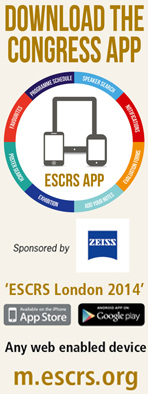
Course handouts are now available
Click here
Come to London

WATCH to find out why
Site updates:
Programme Updates. Programme Overview and - Video Symposium on Challenging Cases now available.
Evaluation of reproducibility of intraoperative wavefront aberrometry and aphakia-based IOL calculation
(results will display both Free Papers & Poster)
Session Details
Session Title: Cataract Surgery Outcomes
Session Date/Time: Tuesday 16/09/2014 | 08:00-10:30
Paper Time: 08:30
Venue: Capital Hall A
First Author: : J.Huelle UK
Co Author(s): : V. Druchkiv T. Katz G. Richard I. Sian S. Linke
Abstract Details
Purpose:
To evaluate reproducibility of intra-operative wavefront aberrometry (IWA) and intra-operative aphakia based biometry.
Setting:
University based consecutive, prospective clinical trial.
Methods:
During routine cataract surgery on 80 eyes, three repeated measures of aphakic spherical equivalent (SE) were generated with IWA. All measurements were objectively graded for their quality. Retrospectively, the IOL that would have given the target refraction, the 'adjusted IOL', was back-calculated from manifest refraction. Regression analysis was performed to generate aphakic SE based formulas to predict this adjusted IOL, the 'predicted IOL'. Two formulas were derived and evaluated in terms of their accuracy in predicting the adjusted IOL. The predicted IOLs were further compared to conventional biometry and to published aphakia formulas stemming from autorefractive retinoscopy.
Results:
In 35,87% of patients, three consecutive aphakia measurements succeeded. The average quality score over these measurements was 42.49% (SD 18.18%) with a test retest reliability of 0.99. The IOL power predicted by our formula was in 24.0% and 53.33% of all cases ±0.5D and ±1D within target refraction, respectively. A second formula that took axial length into account yielded corresponding ratios of 34.67% and 69.33%, respectively. WA aphakia based real time IOL calculation outperformed published autorefractive retinoscopy based aphakia formulas and was less accurate than conventional biometry with the Haigis formula.
Conclusions:
This is the first report to present data on the reproducibility of IWA and its application for aphakia based biometry. To enable reliable IOL calculation from intraoperative WA, measurement precision must be increased, e.g. by controlling for stable anterior chamber conditions and automated quality grading. Randomised controlled trials are necessary in the quest to find a gold standard for intraoperative refraction.
Financial Interest:
NONE


